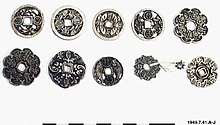Japanese numismatic charm

Japanese numismatic charms (Japanese: 絵銭 or 画銭), also known as Japanese amulets, Japanese talismans, or simply Japanese charms, refer to a family of cash coin-like and other numismatic inspired types of charms that like the Korean and Vietnamese variants are derived from Chinese numismatic charms (also referred to as Yansheng coins or huāqián), but have evolved around the customs of the Japanese culture. Although most of these charms resemble Japanese cash coins and the amulet coins of China, they contain their own categories unique to Japan.
Kokuji charms
Japanese numismatic charms can include characters never used on any official coins such as Kokuji, which is a national script unique to Japan similar to Gukja in Korea or Chữ Nôm in Vietnam, these charms were usually given by village elders to soldiers when they left to fight in the Second Sino-Japanese war and World War II, currently these charms are being used by travellers for supposed protection and are usually sold by shops at shrines.[1][2][3][4][5]
Japanese numismatic Buddhist charms
Japanese numismatic Buddhist charms are Buddhist charms often shaped like cash coins and bear inscriptions asking various figures from the Buddhist faith for blessings or protection, these inscriptions typically have a legend like "大佛鐮倉" ("(The) Great Buddha of Kamakura").[6] The Buddhist "且空藏棄" Japanese numismatic charm cast during the years 1736-1740 in Japan during the Tokugawa shogunate dedicated to the Ākāśagarbha Bodhisattva based on one of the favourite mantras of Kūkai is frequently found in China. Ākāśagarbha one of the 8 immortals who attempts to free people from the cycle of reincarnation with compassion. These coins were brought to China in large numbers by Japanese Buddhist monks, another Japanese Buddhist charm frequently found in China has the inscription "南無阿彌陀佛" ("I put my trust in (the) Amitābha Buddha").[7][8][9]
Other categories of Japanese numismatic charms
References
| Wikimedia Commons has media related to Japanese numismatic charms. |
- ↑ "Zhong Guo Hua Qian" by Yu Liu Liang etc. ( ISBN 7-5325-1220-7), page 498, coin No. 2180.
- ↑ "Japanese Charm with Unknown Characters". Gary Ashkenazy / גארי אשכנזי (Primaltrek – a journey through Chinese culture). 8 July 2011. Retrieved 19 June 2018.
- ↑ Collections (收集) – August 1992 issue.
- ↑ The Kokuji characters on the coin. Retrieved: 19 June 2018.
- ↑ Charm.ru (Chinese Coinage Website) Japanese charm. Comments by Vladimir Belyaev, John Liang, Tan Kuan Yang Gilbert, and Y.K. Leung. Published: 1997. Retrieved: 19 June 2018.
- ↑ "Japanese Charm of the "Great Buddha of Kamakura"". Gary Ashkenazy / גארי אשכנזי (Primaltrek – a journey through Chinese culture). 1 July 2016. Retrieved 19 June 2018.
- ↑ "Buddhist Charms - 佛教品壓勝錢 - Buddhism in China". Gary Ashkenazy / גארי אשכנזי (Primaltrek – a journey through Chinese culture). 16 November 2016. Retrieved 12 May 2018.
- ↑ The Language and Iconography of Chinese Charms - Chapter "Temple coins of the Yuan Dynasty" pp 149-161 Date: 10 December 2016 Temple Coins of the Yuan Dynasty. Vladimir A. Belyaev , Sergey V. Sidorovich. Retrieved = 14 June 2017.
- ↑ Chinese Buddhist Encyclopedia Buddhist Symbols. Retrieved: 12 May 2018.
